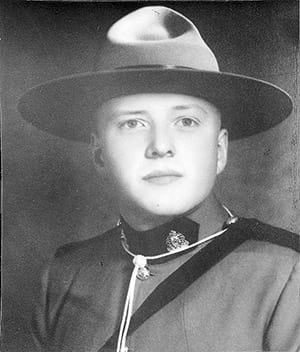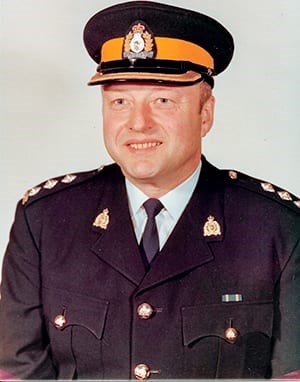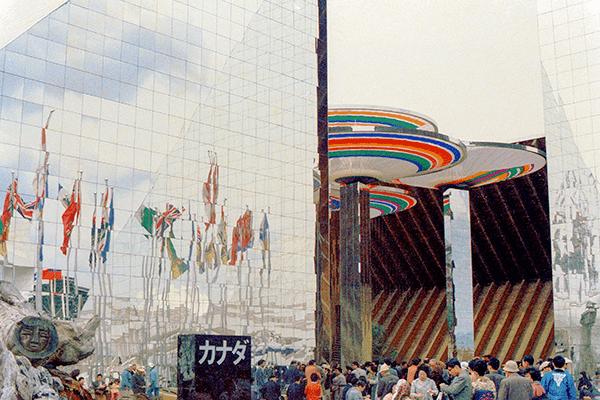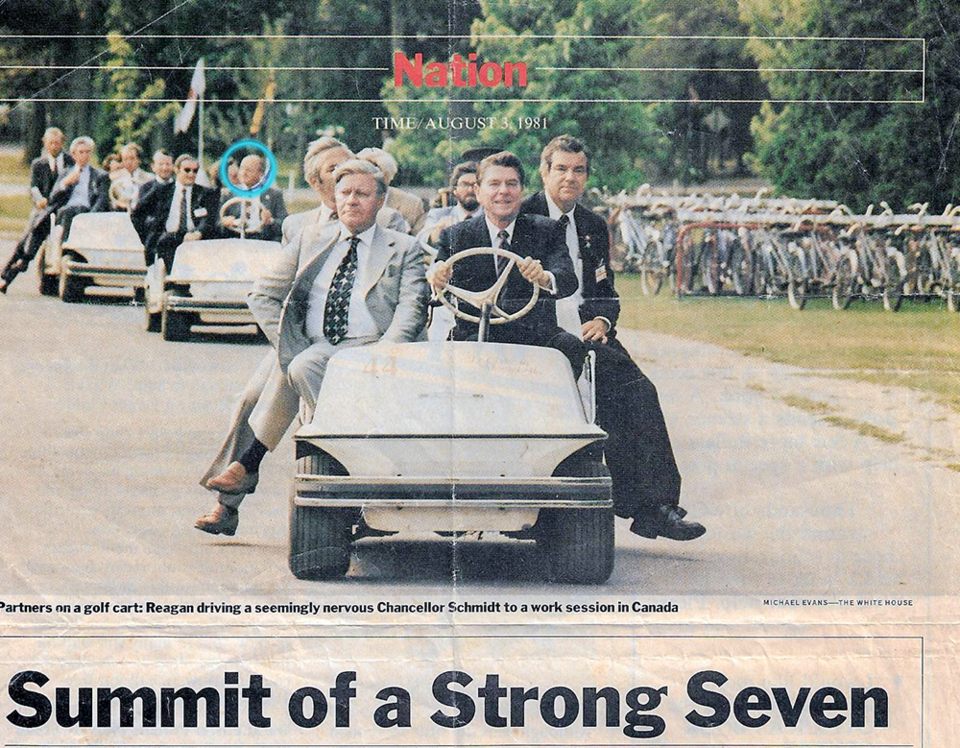One morning my Aunt Gladys was speaking to her son, my cousin Jim, about his plans after high school. It was wasn’t going the way she had hoped.
“But Mother, I don’t want to go on to university.”
“Jim, you need some kind of a career. Are you interested in anything in particular? Science? Medicine? Education?”
“No, none of those. I want a career where I will not be inside all the time. I want adventure. That’s why I like being in the Boy Scout troop so much.”
“What would be your first choice of a career?”
“The RCMP, if they will have me when I am old enough,” Jim answered. “That will be an adventure nearly every day.”
My aunt pondered this decision as she continued with her housework. This boy, her adopted son, was her pride and joy. He came to her as a new baby. Her Irish friend, a nurse in Montreal, gave birth to the boy but had no relatives in Canada. She asked Gladys if she and the baby could come there until she found out what to do about finding an adoptive family. After a few months Gladys decided that she loved this child and would keep him.
Jim Currie grew up in unusual circumstances in a very large household in Niagara-on-the Lake. Aunt Gladys, her five sisters, and her aging mother lived together, as they owned and operating a residential school for Children who Deviated from Normal, as it was called then. Jim’s early playmates at home were these “children” in mind but older in body. That experience would stand him in good stead in his career. He made more friends at school and soon he joined the Boy Scout troop that he grew to love.
After high school he was accepted into the RCMP, who trained their recruits in Regina in troops of 32. How different this life was now! Jim looked into the huge room where he would be spending the next six months and thought of his big bedroom at home with one bed. Now here he was sharing a huge room with 32 unknown guys. In his first letter home, he mentioned those who snored, who swore, who started small conflicts but were silenced by others.

“We are now to work as a unit and not as individuals,” he wrote, “and it’s pretty hard for some of them to accept.”
Jim was a husky young man of 18, weighing over 200 pounds, so some of the physical training was difficult for him to keep up. He would go into the gym after training hours and practice most evenings. His Uncle Will would often find him there when he came to visit Jim. Will was the superintendent of the western division of the Canadian Pacific Railway, and he and his family had lived in Regina for many years.
In his few spare moments, Jim wrote home.
“This place is all geared on organization and being able to handle criticism and being yelled at. It’s a mind game, so in Physical you turn your mind off, and in Academic you turn off your body. We wake at five, shower, then make our bed which takes at least 15-20 minutes. It has to be perfect —no wrinkles — flat ironed sheets.”
In another letter: “We have to run everywhere — we have half our uniform (dark brown fatigues, uniform shirt) but in two weeks we will get our blue dress uniform. Then we will not have to run everywhere. The subjects we take are law, effective speaking, human relations, crime prevention, firearms, driver training and handling prisoners. There are other troops training at different stages, too.”
After graduation day, Jim headed for his duties in Cochrane, Alberta. He had good adventures there, meeting new people and feeling proud of his work and dedication. The experienced officers took the new recruits under their wing for the first few weeks. As he was near the Rockies in the Cochrane area, some of his work was in the mountains — bootleggers up a trail — many rescues of skiers, rescues from plane accidents, rescuing after avalanches, etc. This was all new territory to Jim and he loved it.
One harrowing experience was the rescue of a man from a downed plane high up on a mountain. The call came in and the Mounties had to go immediately. There was no time to return to base to exchange their ordinary clothes for warmer clothing and boots. Jim’s letter is full of compassion for the downed man, and also the trials he and the other officers experienced in their rescue journey to find him. Five handwritten pages to his mother told the story.
We got the call about a downed plane and had to climb several mountains through several blizzards to reach the guy
“You’ll never believe it but I am writing this letter from a bed in the military hospital. The newspaper clipping I’ve enclosed will explain pretty well why I am here. I will be fine but had to recuperate from frostbite of my ear. Swollen feet keep me from walking, and my windpipe is healing from inhaling so much cold air. We got the call about a downed plane and had to climb several mountains through several blizzards to reach the guy. We had to cut the whole top of the plane off to get him out. Both his hands and feet were frozen solid but he was still conscious after sitting in the plane for 33 hours. We got him down the mountain on a toboggan where an ambulance took him to hospital in Calgary.”

After several years, Jim wrote in one of his regular letters to his mother, “I am appointed to be in charge of all security at the Canadian Pavilion for Expo '70 in Osaka, Japan. It is a great appointment and I am excited to do it. Security means that I am to be there before the first shovel goes into the ground for the Pavilion, which is to be a hollow pyramid of mirrors with the interior of a pond, flowers and floating stage — truly one-of-a-kind.”
It turned out to be the most visited of all the countries’ pavilions. He went on, “My duties include greeting all the dignitaries, officials and royalty who attend. Security is intense but I will have good guys for support.”
Gladys was again so proud of her son’s accomplishments.
In September 1969, Jim arrived in Osaka to a whole new adventure in language, customs, living arrangements, the fast train at 125 mph from Tokyo to Osaka, huge masses of people, but also friendly people who wanted to practice their English when they saw a foreigner. In October he moved into his apartment. By mid-November the security coverage started and by then several RCMP officers had arrived. By now Jim was a sergeant.
By opening day on March 15, all was ready. The Canadian pavilion was host to the Japanese Emperor— the only pavilion he visited. Security was intense, the RCMP being joined by some Ontario and Quebec Provincial Police. What could have been a problem with carrying firearms—not permitted in Japan—was solved by sending the RCMP’s weapons to Osaka, where they were rendered useless but still worn.

The continuous entertainment in the Canadian pavilion was exceptional. The floating stage showcased the cast of Anne of Green Gables, the Feux Follets of Montreal, the National Ballet, musicians, the RCMP Musical Ride with their 36 horses, several bands, and the Scandinavian Gymnasts from Montreal, to name a few.
Jim complained about the very hot weather during the summer, when the mounties had to wear their red serge uniforms at all times. He always wanted to be presentable in uniform as he met the VIPs and often accompanied them into the exhibits. The Japanese Emperor was the first; some of the others were Prince Charles, the Prime Minister of Japan, the President of Czechoslovakia, many Provincial premiers of Canada, and the heads of state of many countries. The Japanese had underestimated the numbers that would be attending and the crowds were immense. Often the staff could not get to work on time. 9 AM lineups were huge and continued all day.
In September 1970, Jim wrote, “The last month has surprised everyone with massive crowds. Two days ago, 835,000 poured into the site which completely overwhelmed all facilities. Yesterday they stopped people at 5 PM when the total reached 750,000 and they nearly had riots at each gate. Everyone is worn to a frazzle. I will be striking out for home around November 2nd.”
In Jim’s rare spare time he wandered around the exhibits dressed in plain clothes. By October, many of the exhibits were being dismantled. He enjoyed seeing the German pavilion and especially had a good look at their main display of their Mercedes car. He wrote on October 14, 1970, “I have finally completed arrangements to purchase the Mercedes 280 SEL from the German Pavilion and it will be shipped to Vancouver and should be waiting for me when I arrive. I will then drive on to Edmonton via Calgary. I have also bought a great deal of electronic and photographic equipment over here as the cost is over 40-50 percent less. After you have been out of Canada for more than a year it is tax and duty free.”
So Jim came home to Canada, and looked forward to Christmas with his mother, aunts, cousins and friends.
A few years later, Jim was promoted to sub-inspector and came to Winnipeg as an assistant staffing officer. He often had the job of security for international summit meetings that were held in Canada during the presidency of Ronald Regan. He would meet several world leaders.

Another promotion was as sub-inspector of RCMP offices around the world. Wherever there is a Canadian Embassy there is an RCMP office. He travelled to many European countries, but also to South America, India and some islands. After the business part he arranged holiday times of discovery. He truly had his life of adventure that he wanted as a child.
Back in Canada in retirement he asked his mother if she would like to travel west with him some time. He had always wanted her to see where he had lived and worked. She said yes very quickly. She was living on her own, had retired from their business and was only 96. He said afterwards that it was one of the best trips he had ever had, as she was so keen to see everything. For her part she was happy to meet his western friends and to see where Jim had worked.
Jim married a lovely lady, Ola, after a year or so. Aunt Gladys was pleased to be at his wedding. But within a year he became very ill with esophageal cancer, had the surgery but survived only a short time after his mother’s death, at age 100. Two deaths of two great people. ◆


